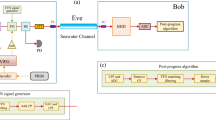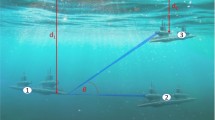Abstract
With the booming development and application of ocean exploration and investigation, it has become more and more important to achieve underwater communications for the establishment of global networks. This paper deals with a Monte Carlo-based performance analysis on multi-mode continuous-variable quantum key distribution over underwater links, where Monte Carlo model can characterize the complex probability density of underwater components. Compared with previous studies carried out in single-mode setting, the multi-mode protocol admits higher secret key rate. Last but not least, using non-Gaussian operations, we further improve the performance of multi-mode protocol, since it increases and distills entanglement in Gaussian entangled states.










Similar content being viewed by others
Explore related subjects
Discover the latest articles, news and stories from top researchers in related subjects.Data availability
The datasets generated during and/or analyzed during the current study are available from the corresponding author on reasonable request.
References
Lo, H.K., Curty, M., Tamaki, K.: Secure quantum key distribution. Nat. Photonics 8, 595–604 (2015)
Scarani, V., Bechmann-Pasquinucci, H., Cerf, N.J., Dušek, M., Lütkenhaus, N., Peev, M.: The security of practical quantum key distribution. Rev. Mod. Phys. 81, 1301 (2009)
Pomerene, A., Starbuck, A.L., Lentine, A.L., Long, C.M., Derose, C.T., Trotter, D.C.: Silicon photonic transceiver circuit for high-speed polarization-based discrete variable quantum key distribution. Opt. Express 25, 12282 (2017)
Shor, P.W., Preskill, J.: Simple proof of security of the bb84 quantum key distribution protocol. Phys. Rev. Lett. 85, 441–444 (2000)
Zhang, G., Haw, J.Y., Cai, H., Xu, F., Assad, S.M., Fitzsimons, J.F., Zhou, X., Zhang, Y., Yu, S., Wu, J., Ser, W., Kwek, L.C., Liu, A.Q.: An integrated silicon photonic chip platform for continuous-variable quantum key distribution. Nat. Photonics 9, 1–4 (2019)
Qi, B., Huang, L.L., Qian, L., Lo, H.K.: Experimental study on the Gaussian-modulated coherent-state quantum key distribution over standard telecommunication fibers. Phys. Rev. A 76, 052323 (2007)
Pirandola, S., Ottaviani, C., Spedalieri, G., Weedbrook, C., Braunstein, S.L., Lloyd, S.L., Andersen, U.L.: High-rate measurement-device-independent quantum cryptography. Nat. Photonics 9, 397–402 (2015)
Weedbrook, C., Pirandola, S., Garcá-Patrón, R., Cerf, N.J., Ralph, T.C., Shapiro, J.H., Lloyd, S.: Gaussian quantum information. Rev. Mod. Phys. 84, 621 (2012)
Grosshans, F., Grangier, P.: Continuous variable quantum cryptography using coherent states. Phys. Rev. Lett. 88, 057902 (2002)
Huang, D., Huang, P., Lin, D.K., Zeng, G.H.: Long-distance continuous-variable quantum key distribution by controlling excess noise. Sci. Rep. 6, 19201 (2016)
Lodewyck, J., Debuisschert, T., Tualle-Brouri, R., Grangier, P.: Controlling excess noise in fiber-optics continuous-variable quantum key distribution. Phys. Rev. A 72, 050303 (2005)
Usenko, V.C., Peuntinger, C., Heim, B., Gunthner, K., Derkach, I., Elser, D., Marquardt, C., Filip, R., Leuchs, G.: Stabilization of transmittance fluctuations caused by beam wandering in continuous-variable quantum communication over free-space atmospheric channels. Opt. Express 26, 31106–31115 (2018)
Hosseinidehaj, N., Babar, Z., Malaney, R., Ng, S.X., Hanzo, L.: Satellite-based continuous-variable quantum communications: State-of-the-art and a predictive outlook. IEEE Commun. Surv. Tutor. 21, 881–919 (2019)
Hill, A.D., Christensen, B., Kwiat, P.G.: Advanced techniques for free-space optical quantum cryptography over water. SPIE 9739, 973911 (2016)
Shi, P., Zhao, S.C., Gu, Y.J., Li, W.D.: Channel analysis for single photon underwater free space quantum key distribution. J. Opt. Soc. Am. A Opt. Image Sci. Vis. 32, 349–356 (2015)
Li, D.D., Shen, Q., Chen, W., Li, Y., Han, X., Yang, K.X., Xu, Y., Lin, J., Wang, C.Z., Yong, H.L., et al.: Proof-of-principle demonstration of quantum key distribution with seawater channel: Towards space-to-underwater quantum communication. Opt. Commun. 452, 220–226 (2019)
Ji, L., Gao, J., Yang, A.L., Feng, Z., Lin, X.F., Li, Z.G., Jin, X.M.: Towards quantum communications in free-space seawater. Opt. Express 25, 19795–19806 (2017)
Ruan, X.C., Zhang, H., Zhao, W., Wang, X., Li, X., Guo, Y.: Security analysis of discrete-modulated continuous-variable quantum key distribution over seawater channel. Appl. Sci. 9, 4956 (2019)
Guo, Y., Xie, C.L., Huang, P., Li, J., Zhang, L., Huang, D., Zeng, G.H.: Channel-parameter estimation for satellite-to-submarine continuous-variable quantum key distribution. Phys. Rev. A 97, 052326 (2018)
Mao, Y., Wu, X., Huang, W., Liao, Q., Guo, Y.: Monte Carlo-based performance analysis for underwater continuous-variable quantum key distribution. Appl. Sci. 10, 5744 (2020)
He, M.J., Malaney, R., Green, J.: Multimode CV-QKD with non-gaussian operations. Quantum Eng. 2(2), 40 (2020)
Usenko, V.C., Ruppert, L., Filip, R.: Entanglement-based CV-QKD with multimode states and detectors. Phys. Rev. A 90, 062326 (2014)
Christ, A., Lupo, C., Silberhorn, C.: Exponentially enhanced quantum communication rate by multiplexing continuous-variable teleportation. New J. Phys. 14, 083007 (2012)
Huang, P., He, G.Q., Fang, J., Zeng, G.H.: Performance improvement of continuous-variable quantum key distribution via photon subtraction. Phys. Rev. A 87, 012317 (2013)
Yang, Y., Li, F.L.: Entanglement properties of non-Gaussian resources generated via photon subtraction and addition and continuous-variable quantum-teleportation improvement. Phys. Rev. A 80, 022315 (2009)
Kim, M.S., Park, E., Knight, P.L., Jeong, H.: Non classicality of a photon-subtracted Gaussian field. Phys. Rev. A 71, 043805 (2005)
Zeng, Z., Fu, S., Zhang, H., Dong, Y., Cheng, J.: A survey of underwater optical wireless communications. IEEE Commun. Surv. Tutor. 19, 204–238 (2016)
Kraemer, R.M., Pessoa, L.M., Salgado, H.M.: Monte Carlo radiative transfer modeling of underwater channel. Wireless Mesh networks-security, architectures and protocols, IntechOpen, London (2019)
Kong, M.W., Wang, J.L., Chen, Y.F., Ali, T., Sarwar, R., Qiu, Y., Wang, S.L., Han, J., Xu, J.: Security weaknesses of underwater wireless optical communication. Opt. Express 25, 21509–21518 (2017)
Li, J., Ma, Y., Zhou, Q.Q., Zhou, B., Wang, H.Y.: Monte Carlo study on pulse response of underwater optical channel. Opt. Eng. 51, 066001 (2012)
Gabriel, C., Khalighi, M.A., Bourennane, S., Léon, P., Rigaud, V.: Monte-Carlo-Based channel characterization for underwater optical communication systems. J. Opt. Commun. Netw. 5, 1–12 (2013)
Cox, W.C.: Simulation, modeling, and design of underwater optical communication systems. Ph. D. Thesis, North Carolina State University, Raleigh, NC (2012)
He, M., Malaney, R., Barnett, B.: Multi-mode CV-QKD with noiseless attenuation and amplification, arXiv:2006.02094 (2020)
Acknowledgements
This work is supported by the National Nature Science Foundation of China (Grant Nos. 61872390, 61972418), the Hunan Provincial Innovation Foundation for Postgraduate (Grant No. CX20210250), the Fundamental Research Funds for the Central Universities of Central South University (Grant No. 2021zzts0202), the Outstanding Youth Program of Education Department of Hunan (Grant No. 21B0228), and the Changsha Municipal Natural Science Foundation (Grant No. kq2202293).
Author information
Authors and Affiliations
Corresponding author
Additional information
Publisher's Note
Springer Nature remains neutral with regard to jurisdictional claims in published maps and institutional affiliations.
Appendix
Appendix
The radiative transfer equation describing the propagation behavior of light can be defined as [20, 31]
Here, \(L(z,\theta ,\phi ,\lambda )\) denotes the light radiance at a point, z denotes the distance of the point from the transmitter, \(\theta \) denotes the polar angles, \(\phi \) denotes the azimuthal angles, \(\lambda \) is the wavelength of the light, and r is the radial distance to the source with the notation \(r=\frac{z}{\mathrm {cos}\theta }\). The three terms on the right side of Eq. (18) represent the annihilation photons from the beam, the elastic scattering and the inelastic scattering.
Rights and permissions
About this article
Cite this article
Zhao, W., Shi, R., Ruan, X. et al. Monte Carlo-based security analysis for multi-mode continuous-variable quantum key distribution over underwater channel. Quantum Inf Process 21, 186 (2022). https://doi.org/10.1007/s11128-022-03533-6
Received:
Accepted:
Published:
DOI: https://doi.org/10.1007/s11128-022-03533-6




